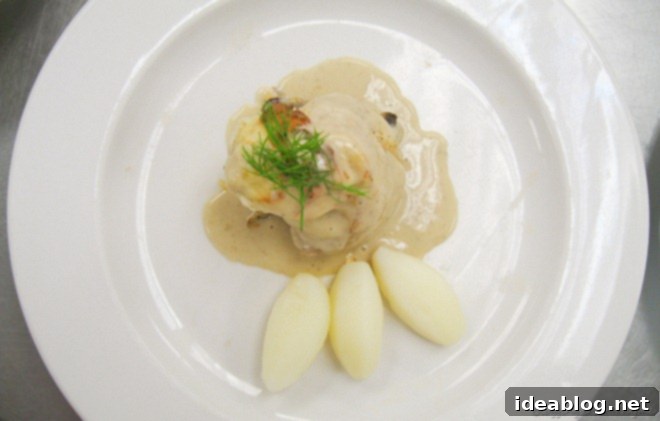Mastering Professional Culinary Arts: A Glimpse into Phase II Training and Fine Dining Excellence
Day Two of Phase II in culinary school unfolded with the promise of new challenges and an early start, a common reality in the world of professional cooking. I found myself at school by 6:15 am, stepping into kitchens that were still silent, empty, and dimly lit. One might assume that arriving so early, with over an hour and a half before the day’s lecture, would lead to downtime. However, as soon as I walked in, it became unequivocally clear: there is always more to do, more to prepare, and more steps to take in anticipation of a bustling day in a professional kitchen. This early arrival is not merely a formality but a crucial opportunity to get ahead and ensure seamless operations.
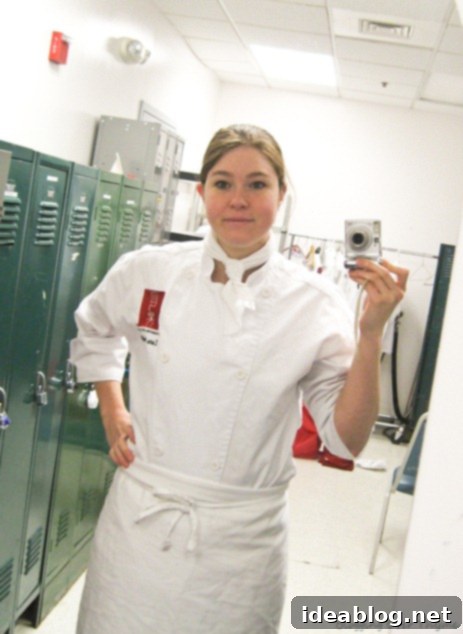
The extensive list of morning tasks is a testament to the meticulous planning required in fine dining. Before any cooking begins, we are responsible for setting up the chef’s demonstration station, ensuring all necessary equipment and ingredients are precisely arranged. Simultaneously, we prep ingredients and meticulously scale specific components for the day’s complex dishes. The classroom itself needs to be equipped with all the chef’s specialized tools. A significant portion of the early morning is dedicated to collecting the daily mise en place – the foundational “everything in its place” of prepared ingredients – from the commissary. Furthermore, maintaining strict food safety standards, we must meticulously fill out refrigerator logs. Only after completing these foundational tasks can we finally begin to focus on our individual stations and prepare our own assigned items, truly embodying the systematic approach of culinary excellence.
My very first assignment upon entering the kitchen was the perennial task of peeling the day’s substantial head of garlic, alongside a generous quantity of shallots. I’m convinced that by the end of these three intense months, my hands will carry the indelible scent of garlic forever, a fragrant badge of honor for any dedicated culinary student.
Shortly after my arrival, Allyson, our dedicated teaching assistant, appeared and immediately assigned me the critical task of scaling out ingredients for the day’s dessert: a delightful Berry Citrus Cake. This was a welcome development, as unlike yesterday, dessert was back on the menu, signifying a return to a full, multi-course service. Fortuitously, this also allowed me to scale out the ingredients for my table’s production, a foresight that proved invaluable. This seemingly small act saved us a surprisingly significant chunk of time once the main production phase commenced, especially given how crowded and competitive the scaling station can become with all students simultaneously vying for space. I genuinely appreciate this proactive aspect of Phase II, where we are encouraged and allowed to take such initiatives, greatly enhancing efficiency and minimizing bottlenecks.
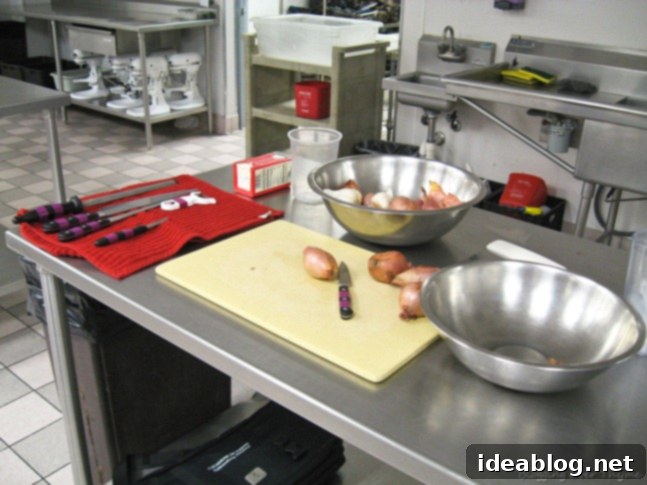
At precisely 8:00 am, the entire class converged in the lecture room for Chef’s demonstration, a vital component of our daily instruction. Today’s demo extended until approximately 10:30 am, leaving us with a tight window before we were scheduled to serve at 12:30 pm – a clear signal that we would need to operate with efficiency and urgency. A recurring theme in Phase II is the application of techniques we’ve already encountered in Phase I, but with a profoundly elevated level of attention to detail and precision. This refinement requires significantly more time, focus, and a relentless pursuit of perfection, preparing us for the exacting standards of professional fine dining environments.
Chef Patrice, our principal instructor, consistently emphasizes a core philosophy: our sole purpose is to serve and, more importantly, to please the customer by producing the absolute best dish possible. His instruction is not just about cooking; it’s about preparing us to excel in a demanding four-star restaurant setting. This rigorous training means that shortcuts are unequivocally forbidden. During his lectures, Chef Patrice meticulously deconstructs every step, from the initial production of a dish to its final, exquisite presentation. He underscores that every decision, every movement, and every ingredient plays a critical role in the ultimate culinary experience.
To vividly illustrate his points, during the demo, Chef Patrice employs a highly effective teaching method. As he prepares a sauce or soup, he’ll create multiple small deli cups containing samples at various stages of completion – before reduction, after adding liquid, at different seasoning points, and after straining. This hands-on approach allows us to visually and sensorially discern the subtle yet significant impact of each adjustment. We learn how he intuitively decides the next crucial step – whether to reduce further, incorporate more liquid, fine-tune the seasoning, or strain for a smoother texture. I’ve found this technique exceptionally useful, as grasping these nuanced aspects of flavor development and culinary decision-making is remarkably challenging when they are merely discussed conceptually. Seeing and tasting the progression is paramount to true understanding and skill acquisition.
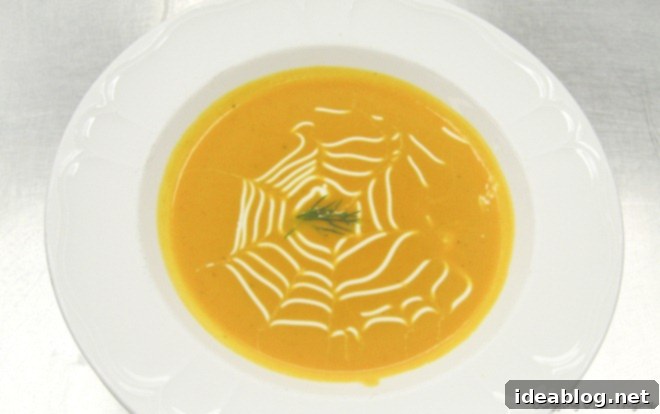
For today’s sophisticated meal, we began with a starter of vibrant butternut squash soup. This rich and creamy soup was elevated with a carefully balanced blend of celery, carrot, and a small, precise amount of Granny Smith apple, introduced for its subtle tartness and complementary sweetness. A significant departure from Phase I, where spices were rarely used to encourage focus on basic techniques, this soup was exquisitely seasoned with warming notes of nutmeg, cardamom, cinnamon, and ginger. The true artistry lies in integrating these aromatic components without allowing any single spice to overpower the others – a delicate balance that demands acute attention and experience. To achieve an exceptionally smooth and refined texture, we passed the processed soup through a chinois (a fine-mesh conical sieve) not once, but twice, before finishing it with a luxurious swirl of cream.
Our thoughtful garnish for the soup was a delicate dollop of sour cream. Unfortunately, the squeeze bottle proved a little temperamental, making precise application challenging, as subtly hinted in the image above. Despite minor plating hiccups, the soup itself was a triumph of flavor and texture, embodying the principles of balanced seasoning and meticulous preparation that Phase II instills.
The centerpiece of our culinary presentation was the main course: elegant paupiettes (meaning “rolls”) of fresh trout. These delicate fish fillets were expertly stuffed and then piped with a light and airy scallop mousse, creating a harmonious blend of textures and flavors. The paupiettes were then gently cooked in a flavorful poaching liquid, carefully crafted with a rich aromatic base. This liquid contained finely sliced shallots, earthy mushroom stems, aromatic fennel scraps, fresh sprigs of thyme, a bay leaf, and an equal blend of delicate fish fumet (a concentrated fish stock) and crisp white wine. The technique involved bringing this flavorful liquid to a gentle simmer on the stovetop, then transferring the entire preparation to the oven, uncovered, allowing the trout to cook slowly and evenly until perfectly tender and flaky. This method ensures that the fish remains moist and infused with the subtle complexities of the poaching liquid.
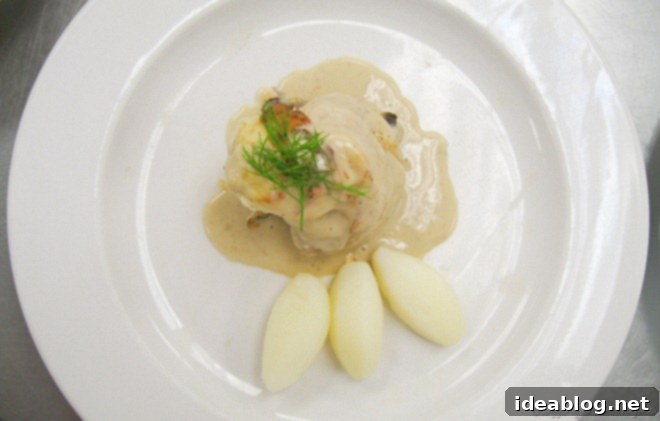
Once the trout reached its ideal doneness, we carefully removed the delicate paupiettes from the poaching liquid. The remaining liquid was then brought back to the stovetop and meticulously reduced until it achieved a concentrated, almost dry consistency, intensifying all its underlying flavors. This potent reduction was then strained through a chinois to ensure absolute clarity and smoothness, creating the foundation for our exquisite sauce. To finish, it was enriched with a touch of fresh cream, a subtle hint of Madeira wine for complexity, and a final swirl of butter, emulsifying into a glossy, velvety sauce that beautifully complemented the trout. This detailed process exemplifies the layered approach to flavor development in fine dining.
We plated the succulent trout on a delicate bed of sautéed fennel, thinly sliced to an almost translucent degree, offering a subtle anise flavor and tender texture. Alongside this, we served perfectly boiled, tourneed potatoes. Tournéeing is a classic knife skill that involves shaping vegetables into elegant, uniform, seven-sided barrel shapes, ensuring even cooking and a refined presentation. While my partner, Jim, masterfully handled the creation of the scallop mousse – a precise and delicate operation – I found myself in charge of tournéeing all the potatoes. What initially felt like a daunting task has, over time, become a meditative exercise; I genuinely no longer mind performing them. It’s a true marker of progress in developing essential knife skills and finding enjoyment in repetitive, precise tasks.
A highlight of the day was the culmination of our efforts in the service component of Phase II. Today, we had the honor of serving our dishes directly to the front of the house, where faculty and esteemed guests dine. Jim and I were assigned the particularly nerve-wracking task of presenting our trout dish to none other than Chef Francois, the formidable director of the entire culinary program. Approximately ten minutes after our plate left the kitchen, Chef Francois himself entered, walked directly to our station, and, with an air of profound authority, inquired, “Who made this?” Jim and I, well aware of his reputation for being notoriously difficult to impress, exchanged a quick, slightly panicked glance before quietly, almost in unison, responding, “We did.” He then proceeded to explain, much to our astonishment, that the dish was “delicious and really well-cooked,” proudly displaying his completely clean plate. I think it’s fair to say we were both utterly shocked and flabbergasted by this rare praise. It was an incredibly validating and gratifying way to conclude service, providing a much-needed boost of confidence and reaffirming the value of our hard work and meticulous attention to detail.
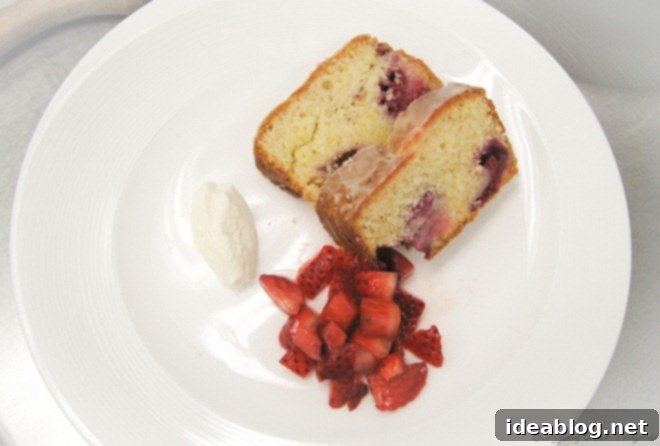
Our impressive meal culminated with a simple yet elegant dessert: a berry and citrus cake. Similar in texture and richness to a pound cake, this delightful creation was infused with the sweet tang of fresh strawberries and raspberries, and finished with a bright, zesty lemon glaze. We presented it adorned with a perfectly formed quenelle of whipped cream – a delicate oval shape scooped with two spoons – and a scattering of extra fresh fruit on the side, enhancing both its visual appeal and its vibrant flavors. It was, without a doubt, pretty delicious! However, for some inexplicable reason, our particular cake proved unusually challenging to slice cleanly, showing a tendency to crumble. This highlights that even seemingly straightforward desserts can present their own unique technical challenges in a professional kitchen environment, demanding adaptability and problem-solving skills.
The most intricate and demanding aspect of the new service component in Phase II is the intense pressure of plating each dish to perfection, followed by the immediate dash to deliver it to the intended recipient in the dining room, all while simultaneously racing back to the kitchen to focus on the next dish that requires plating in quick succession. Our primary objective, and indeed our singular priority, is the “service” plates – the four pristine dishes destined for evaluators and guests. Our own lunches, naturally, take a backseat. This means that, more often than not, our main meal consists of an assortment of leftover scraps and odds and ends, hurriedly consumed between plating sessions. This unique aspect of culinary school service presents both advantages and disadvantages. On the one hand, I’m certainly not consuming as many heavy, calorific meals as I might otherwise, which is a positive. On the other hand, by the time I finally leave school at the end of a demanding day, I’m often quite ravenous. Such is the ebb and flow of life in a professional culinary program – you win some, and you lose some, a constant lesson in balancing priorities and managing personal needs against professional demands.
Having unexpectedly turned this daily reflection into a short novel, it’s time for me to conclude. I’m off to meticulously type up my recipes for the day, ensuring every detail is recorded, and then finally, to enjoy some well-deserved leftovers for dinner. Each day in Phase II is a rigorous, rewarding journey of learning, precision, and the relentless pursuit of culinary mastery.
